It looks like you're using an Ad Blocker.
Please white-list or disable AboveTopSecret.com in your ad-blocking tool.
Thank you.
Some features of ATS will be disabled while you continue to use an ad-blocker.
share:
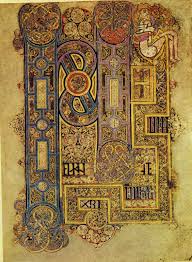
The Book of Kells was written in around 800AD, probably at Iona (or Applecross) in Scotland or maybe in Kells, County Meath, Ireland. It’s also known as the Book of Columba, as tradition has it that it was written to celebrate the 200th anniversary of his death.
St Columba died in 597; 200 years later there were Viking raids on Iona, and so it’s possible that it was smuggled over to Ireland to be kept safe from the hands of the Vikings. Like so much of our history, nobody knows for certain. What is for certain is that the Culdees who wrote and inscribed it have laced the vellum pages with some inexplicable mysteries.
You can look through all of the folios here (680 pages in total) - Trinity College Dublin Digital Collections -and start to appreciate the time and incredible skill that went into making this beautiful book. In some instances, the knot work is so intricate that it can only be seen clearly with a magnifying glass - a tool unavailable to its author.
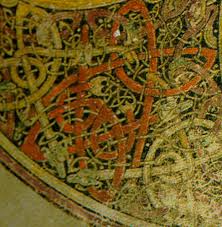
So who were the artists behind this codex?

The Culdees (or Keli Dei, companions or followers of God) were the ‘celtic’ monks, often linked to Columba and more tentatively to the memories of the Druids before them. They were wholly devoted to God and lived apart from the community in monastic fashion. Odd statements from the past still linger, casting speculation as to the roots of this ancient order.
Tertullian (160-225 AD) wrote of "...the haunts of the Britons - inaccessible to the Romans, but subjugated to Christ..." (ch. 7). Source
Maybe he was overplaying the popularity of Christianity in his lifetime, but interesting nonetheless that those places would be Ireland and Scotland.
St. Columba is attributed with the words ‘My Druid is Christ, the son of God,
Christ, Son of Mary, the Great Abbot,
The Father, the Son and the Holy Ghost.’
Columcille and the Druids
I think there may be good reason to link the Culdees with the Druids or to reconsider at least that their practices were not so different as we may have previously assumed.
There are more clues in the Book of Kells. I came across this site whilst wondering about one of the folios in the Book of Kells, and a number of the following images will be taken from it.
Thoth Is The Ibis
I couldn’t understand why St. John is shown with four feet. Two at the bottom of the chair, where they should be, and two beneath the patterned page border.
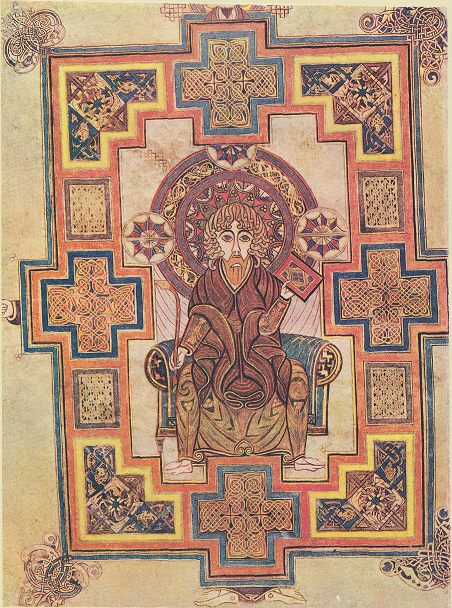
If you look again then you will see that there is a man kneeling in front of St. John. The top of his turban is visible as he looks down at the floor. The first pair of feet are actually his hands; St John’s ‘real’ feet are shown beneath the border. St John’s legs are actually the ‘druid’s’ arms and shoulders.
But why hide him in this picture? What were the monks trying to say?
And does he appear again at the 'Arrest of Jesus'?
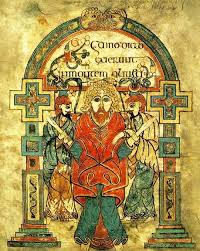
The Celts are famous for hiding faces in their ancient coins and seemed to delight at playing visual tricks. Is this something similar, a leftover from a much older celtic culture?
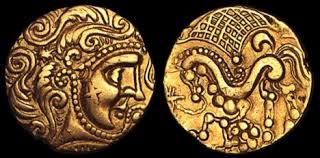
There are more hidden faces, this time on the world famous chi rho page:

Now that we know that hidden figures wear turbans, it should be easier to see.
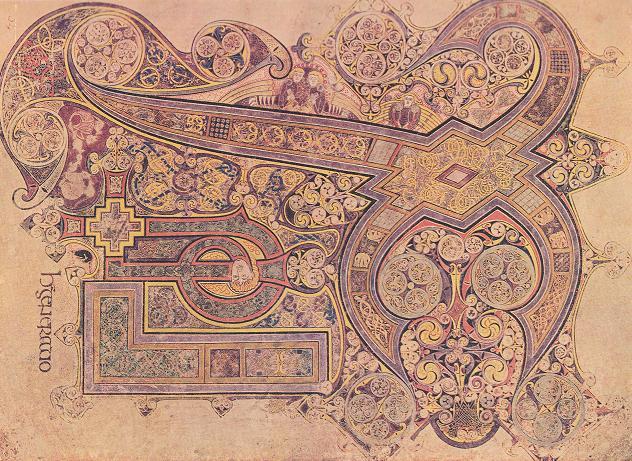
“To me, one of the most marvelous things one the page is the Druid. The C of Christos now becomes the headdress on the Druid. He has two big circles for eyes which have trinity knots in them, and the bridge of his nose is made up of ibis. Two big ones and two small ones. The tip of his nose is below the small ones, and his nostrils flare out into circles. Below the nose he has a moustache which also flares out in circles. His mouth is below the moustache, and is made up partly by two cranes whose beaks run down into his beard. His beard is mostly curly but the centre bottom part is divided and turned into knot work, which has been made into three diamonds inside one another with two parallel lines crossing two parallel lines woven into the diamonds, and they make up the symbol for the hidden secret.
Thothistheibis
(The hidden secret in this instance is the Cygnus theory, a whole other discussion).
Here St. Matthew is given different coloured eyes. Why? These were not the bored scribblings of bored churchmen. Dyes were sourced from the Mediterranean, calf vellum was an expensive resource. Great thought and effort went into this book, each design given time and careful attention.
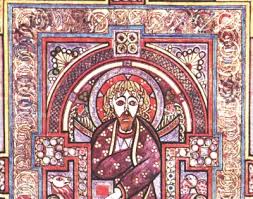
:
"This book contains the harmony of the four Evangelists according to St. Jerome, where for almost every page there are different designs, distinguished by varied colors. Here you may see the face of majesty, divinely drawn, here the mystic symbols of the Evangelists, each with wings, now six, now four, now two; here the Eagle, there the Calf, here the Man, and there the Lion, and other forms almost infinite. Look at them superficially with the ordinary casual glance, and you would think it an erasure, and not tracery. Fine craftsmanship is all about you, but you might not notice it. Look more keenly at it, and you will penetrate to the very shrine of art. You will make out intricacies, so delicate and subtle, so exact and compact, so full of knots and links, with colors so fresh and vivid, that you might say that all this was the work of an angel, and not of a man. For my part the oftener I see the book, and the more carefully I study it, the more I am lost in ever fresh amazement, and I see more and more wonders in the book." Gerald of Canterbury (Topographia Hiberniae (1185)
Book of Kells
There is so much more hidden in these pages –animals, moths, hidden faces in triskeles and one author suggested Ogham.
I hope you will enjoy looking at the Book of Kells with fresh eyes.

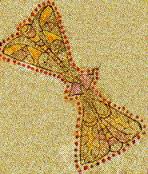
Digital Medievalist
Book of Kells wiki link
Education Scotland
Merry Christmas ATS and a happy, healthy New Year.
B x
a reply to: beansidhe
Thank you for the link to the digital collection. They did an excellent job putting that together. I was impressed by the ability to zoom in and get higher resolution images.
I'm guessing you have already seen the animated movie from 2009 Secret of Kells (imdb).
Thank you for the link to the digital collection. They did an excellent job putting that together. I was impressed by the ability to zoom in and get higher resolution images.
I'm guessing you have already seen the animated movie from 2009 Secret of Kells (imdb).
originally posted by: beansidhe
You can look through all of the folios here (680 pages in total) - Trinity College Dublin Digital Collections -and start to appreciate the time and incredible skill that went into making this beautiful book. In some instances, the knot work is so intricate that it can only be seen clearly with a magnifying glass - a tool unavailable to its author.
Dont underestimate what generations of skill with a craft can do.
Have you seen Viking jewerly and treasures up close in person? We have a ton of them in Swedish museums and they are amazing to see. The intricate details seems completely impossible, its like they where made by alien hands. Extremely tiny alien hands. With the precision of laser cutters. Exactly like the detail of that that book, except made out of gold and silver.
I looked and looked and looked, but couldn't for the life of me figure out how you're seeing a kneeling turbaned guy, unless this is some kind of
hidden kinky porn in the folds of the robe somewhere.
The imagery is indeed beautiful, that is without a doubt.
The imagery is indeed beautiful, that is without a doubt.
a reply to: compressedFusion
You are most welcome, and yes it is a superb project. I'm glad you clicked the link.
No, I've not seen the movie but it kept coming up whilst I was googling, and I can't wait to watch it!
You are most welcome, and yes it is a superb project. I'm glad you clicked the link.
No, I've not seen the movie but it kept coming up whilst I was googling, and I can't wait to watch it!
a reply to: merka
No, never in person but I would love to. You reminded me of this:

Wiltshire Bush Barrow
Some of these pieces seem impossible to us now, but they are testament to incredibly skilled craftsmen and women. Or if the expert above is correct, crafts-children.
No, never in person but I would love to. You reminded me of this:

Only fragments of the original wooden dagger handle survive intact, but originally it was decorated with 140,000 tiny studs, each almost as fine as a human hair and set into the wood at more than 1000 to the square centimetre. The price of such extraordinary work would have been painfully high, leaving some of the young craft workers very short sighted by the age of 15 and partially blind by the age of 20.
Ronald Rabbetts, an expert on the optics of the human eye, believes that only children and young teenagers would have had sharp enough eyesight for the most detailed work more than a thousand years before the invention of any form of magnifying glass.
Wiltshire Bush Barrow
Some of these pieces seem impossible to us now, but they are testament to incredibly skilled craftsmen and women. Or if the expert above is correct, crafts-children.
a reply to: Nyiah
Oh no! How can I explain him better for you? Once you see him, he cannot be unseen!
If he was to raise his head, he would be looking straight at you. He's on his hands and knees in front of St John and he could be in a sort of hidden kinky porny pose, I suppose.
St John's knees are the druid's shoulders, his feet are the druid's hands. It's easier to see if you scroll up the page until St John's head and neck are out of your view, and then you stop focussing on him and the druid becomes clearer.
Hope that helps!
Oh no! How can I explain him better for you? Once you see him, he cannot be unseen!
If he was to raise his head, he would be looking straight at you. He's on his hands and knees in front of St John and he could be in a sort of hidden kinky porny pose, I suppose.
St John's knees are the druid's shoulders, his feet are the druid's hands. It's easier to see if you scroll up the page until St John's head and neck are out of your view, and then you stop focussing on him and the druid becomes clearer.
Hope that helps!
a reply to: beansidhe
Theres a long person in the background. upper torso at the top of the page, and the feet end at the bottom of the page.
Very slender, But not seeing the turban you described.
Maybe the person on the outside of the pages is john as well? But there is no one kneeling in front of john.
His hands also extend on the outside of the pages as well on the left and right side. So its like the strechy guy from fantastic 4
Theres a long person in the background. upper torso at the top of the page, and the feet end at the bottom of the page.
Very slender, But not seeing the turban you described.
Maybe the person on the outside of the pages is john as well? But there is no one kneeling in front of john.
His hands also extend on the outside of the pages as well on the left and right side. So its like the strechy guy from fantastic 4
edit on
24-12-2014 by AnuTyr because: (no reason given)
that's curly blond hair and a red beard on john btw lol. weird. Iv got blond hair and a black beard.
a reply to: beansidhe
I enjoyed your thread, although I wouldn't have used this phrase - the monks who created these manuscripts were not "bored," I would hazard a guess they quite enjoyed this type of devotional work. This artist was exceptional, and probably delighted in working in drafting these pages. Besides, the alternative was toiling in the fields.
Why? These were not the bored scribblings of bored churchmen.
I enjoyed your thread, although I wouldn't have used this phrase - the monks who created these manuscripts were not "bored," I would hazard a guess they quite enjoyed this type of devotional work. This artist was exceptional, and probably delighted in working in drafting these pages. Besides, the alternative was toiling in the fields.
In the image of St John with the "four feet", I see what looks like a hand on the left side of the bordering, poking outside the border. There may
be another hand on the right side, but the image is cut off... I wonder if the whole unadulterated, unedited image exists somewhere online?
For those who have trouble seeing the figure proposed by the op, he is supposed to be facing us, not facing John. This may make it a little easier to see "him".
I recently watched a show...I can't remember exactly what it was about, but they were examining something made of gold, and it was held together by these tiny gold pins, each one the size of maybe 3 grains of sand lined up together. They had an expert craftsman who specializes in gold look at them, and he said that it had to be children who created them (im assuming with the guidance of adults) because they have better eyesight than adults. And I imagine the smaller hands would help too...
So, I don't know if this guy is correct, but I just thought I would share that with you.
For those who have trouble seeing the figure proposed by the op, he is supposed to be facing us, not facing John. This may make it a little easier to see "him".
I recently watched a show...I can't remember exactly what it was about, but they were examining something made of gold, and it was held together by these tiny gold pins, each one the size of maybe 3 grains of sand lined up together. They had an expert craftsman who specializes in gold look at them, and he said that it had to be children who created them (im assuming with the guidance of adults) because they have better eyesight than adults. And I imagine the smaller hands would help too...
So, I don't know if this guy is correct, but I just thought I would share that with you.
a reply to: beansidhe
Fascinating dagger handle! But that's not the same thing I saw on the show I mentioned... what I saw, as best I can remember... was some kind of breastplate, made of gold. I wish I could remember more. I think they found it on a corpse, so maybe it was specifically for funeral purposes... Each pin, i think, was made of 2 seperate thin gold wires twisted together, then tapped on each end to creste a rivet effect, to hold two peices of the plate together. There were maybe 200 of these pins.
Fascinating dagger handle! But that's not the same thing I saw on the show I mentioned... what I saw, as best I can remember... was some kind of breastplate, made of gold. I wish I could remember more. I think they found it on a corpse, so maybe it was specifically for funeral purposes... Each pin, i think, was made of 2 seperate thin gold wires twisted together, then tapped on each end to creste a rivet effect, to hold two peices of the plate together. There were maybe 200 of these pins.
Check the red circles:
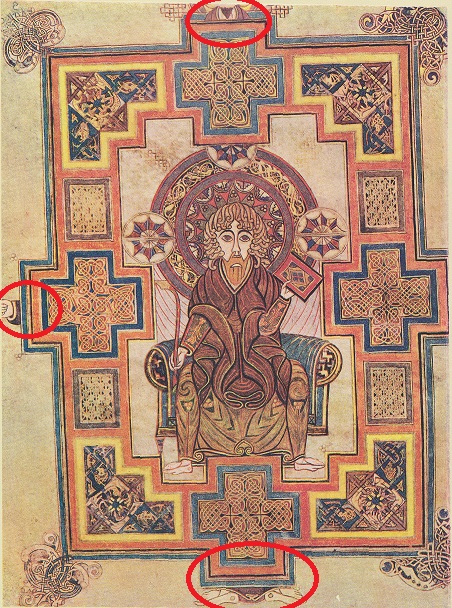
It appears to be a man in the background (his head and left hand are cut off due to the lopsided photograph of the book page). Methinks you have druids on the mind!

It appears to be a man in the background (his head and left hand are cut off due to the lopsided photograph of the book page). Methinks you have druids on the mind!
There is a head at the top too, you're right. Is there something about the story of John that would explain him being there?

I think the picture is showing that John has a expanded (cosmic?) state, similar to this..
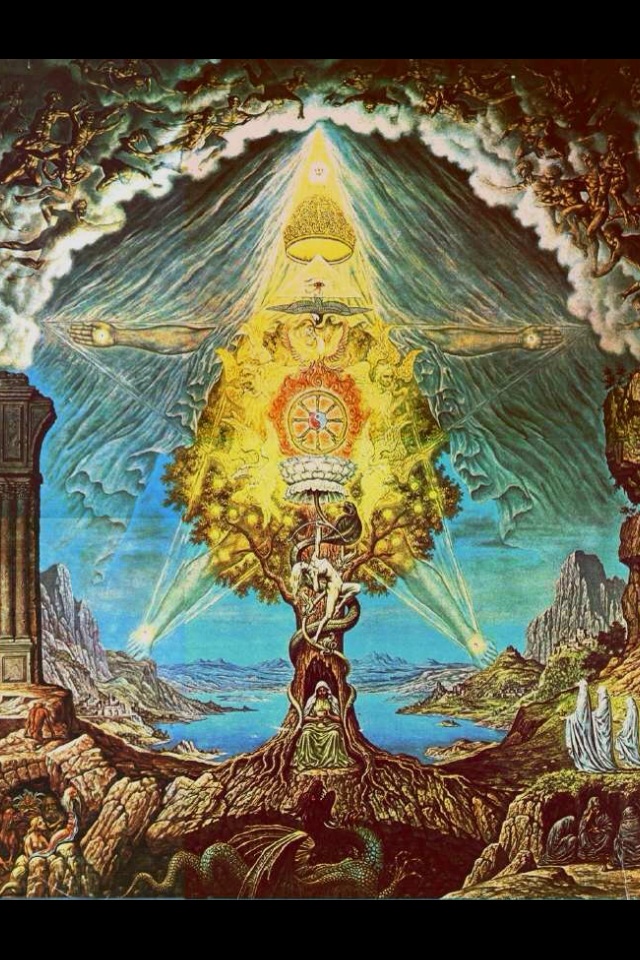
edit on 25-12-2014 by Wifibrains because: (no reason given)
This cho rhi page is very psychodelic and reminds me of other testimony of this realm...
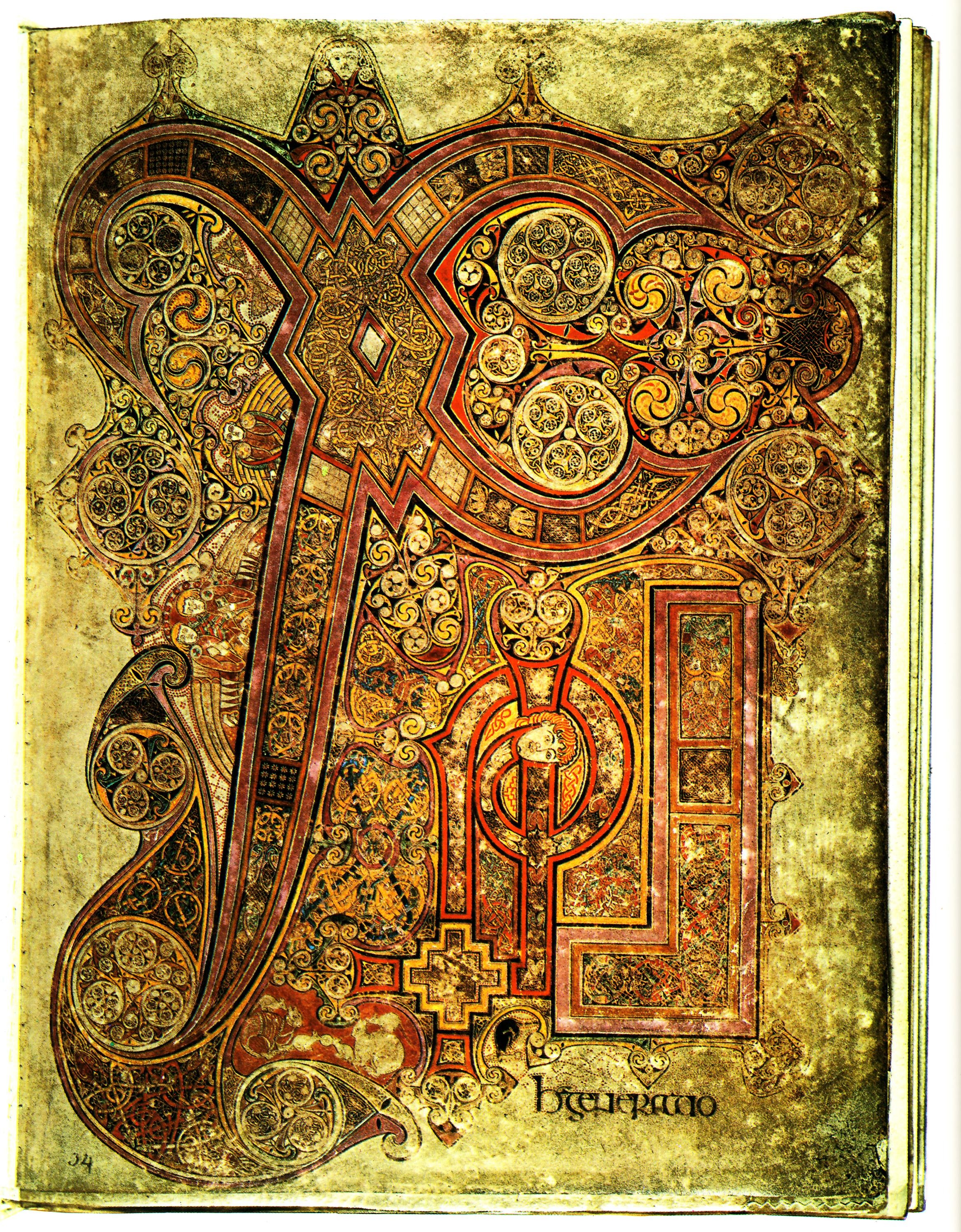
Alex Grey, eat your heart out.

Alex Grey, eat your heart out.
edit on 25-12-2014 by Wifibrains because: (no reason given)
new topics
-
Shocking moment four men 'try to force Jewish pedestrian into car boot' in North London
Breaking Alternative News: 1 hours ago -
The 'Censorship-Industrial Complex'. It is coming to a nation state near you, any time now...
New World Order: 2 hours ago -
BREAKING: Astrazeneca admits for the first time its vaccine can cause deaths and serious injuries
Medical Issues & Conspiracies: 5 hours ago -
New Bombshell Evidence Strongly Suggests Trump was Set Up in Classified Docs Saga
US Political Madness: 10 hours ago
top topics
-
New Bombshell Evidence Strongly Suggests Trump was Set Up in Classified Docs Saga
US Political Madness: 10 hours ago, 28 flags -
Expert Says Parents Should Ask Babies Permission to Change Nappies.
General Chit Chat: 14 hours ago, 10 flags -
BREAKING: Astrazeneca admits for the first time its vaccine can cause deaths and serious injuries
Medical Issues & Conspiracies: 5 hours ago, 9 flags -
One More Night at the Pig and Blanket (Time 2024)
Short Stories: 13 hours ago, 5 flags -
Do you name your cars ?
General Chit Chat: 16 hours ago, 4 flags -
Shocking moment four men 'try to force Jewish pedestrian into car boot' in North London
Breaking Alternative News: 1 hours ago, 3 flags -
Hard evidence of a Royal plot on the US....if only i had proof.
ATS Skunk Works: 15 hours ago, 2 flags -
The 'Censorship-Industrial Complex'. It is coming to a nation state near you, any time now...
New World Order: 2 hours ago, 1 flags
active topics
-
Shocking moment four men 'try to force Jewish pedestrian into car boot' in North London
Breaking Alternative News • 12 • : andy06shake -
The 'Censorship-Industrial Complex'. It is coming to a nation state near you, any time now...
New World Order • 3 • : Lochid -
Biden Banning Menthol Cigarettes - Good Health Move or Government Overreach?
US Political Madness • 93 • : annonentity -
BREAKING: Astrazeneca admits for the first time its vaccine can cause deaths and serious injuries
Medical Issues & Conspiracies • 4 • : Lochid -
New Bombshell Evidence Strongly Suggests Trump was Set Up in Classified Docs Saga
US Political Madness • 41 • : network dude -
Gov Kristi Noem Shot and Killed "Less Than Worthless Dog" and a 'Smelly Goat
2024 Elections • 133 • : FlyersFan -
Canada caught red-handed manipulating live weather data and make it warmer
Fragile Earth • 32 • : JPRCrastney -
Say his name
US Political Madness • 43 • : 19Bones79 -
Hamas and Other Islamist Terrorist Groups Announce Support of US Campus Anti-Israel Protests
Education and Media • 22 • : FlyersFan -
New whistleblower Jason Sands speaks on Twitter Spaces last night.
Aliens and UFOs • 79 • : andy06shake
